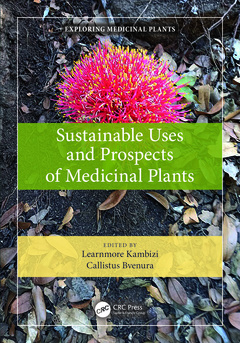Sustainable Uses and Prospects of Medicinal Plants Exploring Medicinal Plants Series
Coordonnateurs : Kambizi Learnmore, Bvenura Callistus

Sustainable Uses and Prospects of Medicinal Plants presents information on less known and underexplored medicinal plant species in various regions of the world. The book investigates current advances in medicinal plant science and includes detailed information on the use of green nanotechnology, characterization of plants, conservation, revitalization, propagation, and pharmacological activities of selected plants. A volume in the Exploring Medicinal Plants series, it collects information on less known medicinal plant species in various regions of the world for documentation profiling their ethnobotany, developments in their phytochemistry, and pharmacological activities and provides an in-depth look at some specific herbal medicines of importance, threatened and less known species and addresses sustainable utilization and conservation of medicinal plants to ensure existence and use.
Appropriate for plant and biodiversity conservation organisations, community leaders, academicians, researchers, and pharmaceutical industry personnel, the book comprises innovative works with information of what is expected to address sustainability in the future.
- Sustainable uses of medicinal plants and prospects: a brief overview
- Protecting the endemism of threatened cyclotide-rich medicinal plants: The tropical African experience
- Traditional medicinal plant use in improving the livelihoods and well-being of Namibian communities
- Antiviral and Immune Boosting Potentials of Four Common Edible Flowers
- Characterization and docking studies of immunomodulatory active compounds from Rhododendron arboreum Sm. leaves
- Herbal and Traditional Medicine Practices against Viral Infections: Perspectives against COVID-19
- Traditional herbal remedies used in management of acute bronchitis, common cold and severe acute respiratory syndrome coronavirus-2 in Southern Africa
- Solanum nigrum seedviability and germination and soil modulationeffect on seedling emergence
- Indian medicinal plants and their potential against coronaviruses
- Scientific Evaluation and Biochemical Validation of Efficacy of Extracts and Phytochemicals from Zimbabwe: A Review of Prospects for Development of Bioproducts
- Sustainable agricultural practices of industrially utilized tropical medicinal plants
- Prospects for sustainable cultivation of medicinal and aromatic plants in India
- The role of indigenous knowledge systems in sustainable utilization and conservation of medicinal plants
- Metabolomics approach: A tool for understanding Alzheimer’s Disease
- Can phylogenetics clear plant taxonomic confusion for conservation and sound bioprospecting?
- Spices as potential human disease panacea
- Commercialization of medicinal plants: Opportunities for trade and concerns for biodiversity conservation
- Ethnomedicinal and other ecosystem services provided by threatened plants: A case study of cycads
- Discovery of antibacterial lead compounds from three South African marine algae
- An endophytic Beauveria bassiana (Hypocreales) strain enhances the flavonol contents of Helichrysum petiolare
- Ethnobotanical study of plants used for the management of diabetes mellitus in South Africa
- Traditional healthcare practices of herbal drugs in Uttarakhand Himalayas, India
- Physicochemical characterization, antioxidant, and anti-inflammatory activities of turmeric-black cumin home-grown COVID-19 herbal mixture
- Medicinal plants and the challenges of climate to health security in Nasarawa State, Northwest Nigeria
Professor Learnmore Kambizi (Cape Peninsula University of Technology, South Africa) attained his BSc degree from Cuba in 1998 before enrolling for Masters and PhD degrees at the University of Fort Hare which he completed in 2004. His PhD focussed on Ethnobotanical studies of plants used for the treatment of sexually transmitted infections in South Africa. He went on to pursue a postdoctoral fellowship within the fields of Ethnobotany & Phytomedicine. This discipline enabled him to realise his passion for sustainable utilisation and conservation of medicinal plants on a local and international level. He worked as a Lecturer at the University of Zimbabwe in 2005 before moving to the University of the Free State, South Africa in 2007. In the same year, he was appointed by Walter Sisulu University as a Senior lecturer until 2011. He moved to Cape Peninsula University of Technology, South Africa where he was promoted to the position of Associate Professor, a position he holds to date. In his academic journey, he has hosted 4 postdoctoral fellows and supervised 5 PhD, 16 master’s and numerous Honours students. To date he has published over 50 articles in peer reviewed journals and presented 56 conference papers. He is a South African National Research Foundation rated researcher. Prof Kambizi has also served as a panel member of the National Research Foundation of South Africa and has received many research grants to support post graduate students and to assist communities. He also works with Traditional Medical Practitioners in collaboration with the South African Research Council as an advisor. In addition, Prof Kambizi was appointed the first Director of African Centre for Herbal Research based in Nigeria, a position he holds to date. He is a reviewer of many national and international journals.
Dr. Callistus Bvenura (Cape Peninsula University of Technology, South Africa) graduated with a BSc in Natural Resources Management and Agriculture in 2006 from th
Date de parution : 05-2023
17.8x25.4 cm
Thèmes de Sustainable Uses and Prospects of Medicinal Plants :
Mots-clés :
desertification; green nanotechnology; pharmacologial; phytochemistry; preservation; conservation; sustainable; medecine; Middle East Respiratory Syndrome Coronavirus; herbal; MERS; Tamil Nadu; APG III; Middle East Respiratory Syndrome; SARS CoV; Medicinal Plants; Withania Somnifera; MRSA Growth; Sample Preparation; Essential Oils; Nigrum Seeds; DNA Barcoding; Frap Activity; Highest Seedling Emergence; Moisture Content; Devil’s Claw; Nasarawa State; Red Chili Pepper; Acute Bronchitis; UPLC MS Analysis; Cycas Species; Black Cumin Seeds; Black Cumin Oil; IUCN Red List



